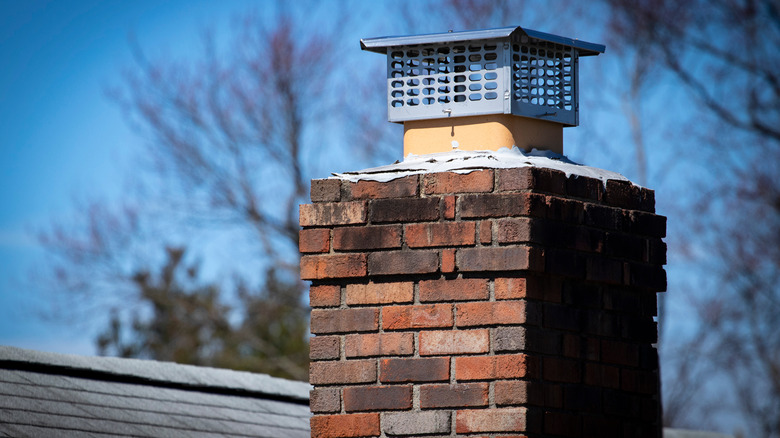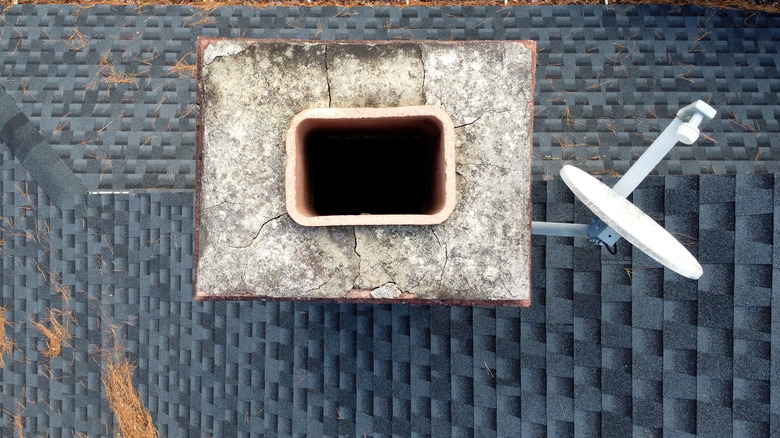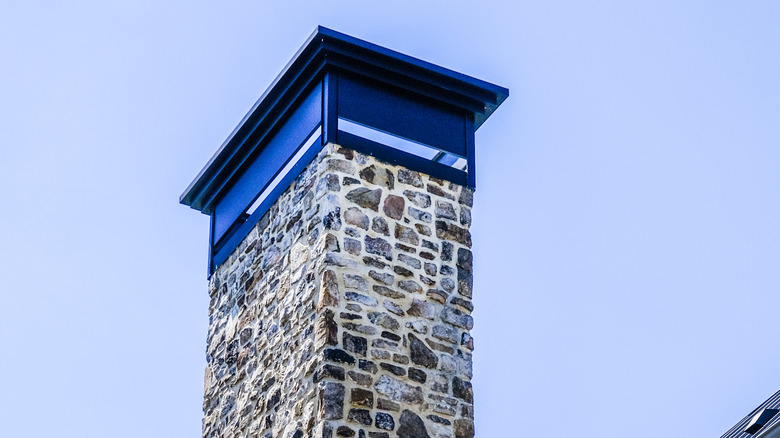What It Means If You See A Cap On Someone's Chimney
Take a look up to the roof of a home to spot the chimney. Typically brick in structure, chimneys help move smoke and exhaust from the home's fireplace. Chimneys are highly durable and tend to handle most environmental conditions. However, they have a single problem — they have an opening at the top that allows smoke to rise, with obvious good reason, but that hole also allows moisture to get in. To solve this, most homes use a chimney cap.
A chimney cap is a very important top component of your home fireplace. It works to keep the elements out of the home. If you don't have a cap on the chimney, rain, snow, and even drafts from intense wind can enter the home. The cap may also help discourage unwanted critters from making your chimney or fireplace their home. Most chimney caps are made of metal, such as steel or copper mesh. Some can be colored or styled to match the home's aesthetic or the roof itself. It's critical to have this cap, no matter if you use your fireplace or not.
As a property owner, if your house has a fireplace or a chimney for any other reason, you should have it inspected every year (if you use it) or every few years otherwise to ensure that the structure is stable and sealed. You should hire a professional to clean your chimney and inspect your cap on a routine basis. If your cap is working perfectly, you should be able to minimize problems with your chimney.
Understanding the structure of the chimney
If you see a cap on a chimney, that's a good thing. The cap sits at the very top of the structure of the chimney. The cap sits right on top of the crown, which then connects to the chimney flue. The flue is the portion of the system that runs from the top of your roof down to the fireplace itself. It's typically a piece of ducting or a pipe that's designed to funnel smoke and soot upward and out of your home. This helps ensure the chemicals from whatever is burning in the fireplace don't come into the home itself.
The flue needs an opening at the top of the chimney to allow for the escape of these materials. Yet the flue also inadvertently creates a straight channel for the elements to enter your home and travel down the chimney structure. While your chimney is certainly durable and able to withstand all types of conditions, any amount of moisture isn't ideal. Over time, the constant rain and moisture will break down the mortar and the bricks in the interior of the structure. In addition, it can also cause damage and rust to other structures within the chimney, including dampers, walls, and the fireplace ceiling. These are typically expensive repairs that you don't want to have to make.
The chimney cap helps to lower this risk. It prevents all of that rain from getting into the flue, protecting all of these components and extending the life of your chimney.
Additional benefits of having a chimney cap
Chimney caps come in two basic options. The first is a flue-top chimney cap, which is generally cheaper, while the second is a full-width cap, which offers more extensive protection overall. These tend to be more appealing since they can be designed to look more elaborate. All methods provide the same benefits of keeping precipitation out of the chimney and flue.
The warmer weather often brings in nesting animals looking for protection. No one wants to have to deal with raccoons, baby birds, or squirrels living and getting stuck in the chimney, and a functional chimney cap should prevent that. Even if you don't use the fireplace, you still don't want to find a sick or stuck animal in your chimney with direct access to your house.
Caps also work well to block downdrafts. A downdraft happens when strong winds blow down your chimney, making your home colder. Downdrafts can also send smoke into your home, which not only would probably set off your smoke alarm, but it's a health hazard as well. Caps help to prevent out-of-control fires, too, by preventing material like twigs or leaves from falling or being blown into the chimney and blocking it. With good chimney and fireplace maintenance, along with a cap in place, you protect your home and family from a variety of risks.


